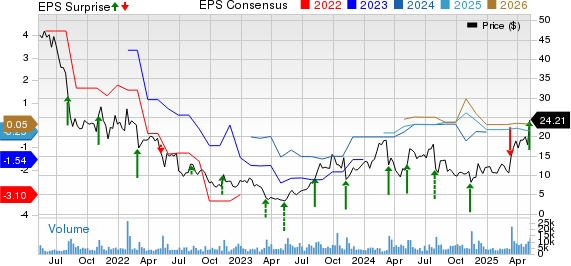Dollar Index Gains Amid Trade Deal Optimism, IMF Cuts Global Growth Forecast
The dollar index (DXY00) rose by +0.65% on Tuesday, moderately recovering from Monday’s three-year low. Optimism regarding a bilateral trade deal with India contributed to the dollar’s rebound as U.S. trade negotiators reported “significant progress” following talks between Vice President Vance and Indian Prime Minister Modi. Additionally, the dollar gained momentum due to indications that the U.S.-China trade tensions may be easing. Bloomberg News highlighted that Treasury Secretary Bessent told investors at a closed-door summit that the ongoing tariff dispute with China is “unsustainable” and expects a de-escalation.
Despite these gains, the dollar faced limitations after the April Richmond Fed manufacturing survey revealed a drop in current conditions to a five-month low, falling to -13 from -4. Economists had anticipated a decrease only to -7. Moreover, concerns persist over the future of the Federal Reserve, particularly amid fears that President Trump could attempt to remove Fed Chair Powell. Such actions would undermine the Fed’s independence, potentially diminishing confidence in the dollar. The dollar’s strength is further challenged by aggressive trade tariffs, which have caused some foreign investors to liquidate their dollar-denominated assets.
Join 200K+ Subscribers: find out why the midday Barchart Brief newsletter is a must-read for thousands daily.
The April Richmond Fed manufacturing survey index showed a surprising decrease of -9 points, significantly weaker than forecasted. Minneapolis Fed President Kashkari indicated that tariffs might lead to inflation, yet it’s premature to determine their influence on interest rate trajectories. Similarly, Richmond Fed President Barkin highlighted that firms are taking a defensive stance due to tariffs, leading to project delays and deferring investments. Concerns about consumer spending remain prevalent.
In a related note, the International Monetary Fund (IMF) revised its global GDP forecast for 2025 down to +2.8% from +3.3% previously estimated in January. The IMF warned that the outlook could further decline due to escalating trade conflicts linked to U.S. tariffs. It has also lowered its U.S. GDP forecast for 2025 to +1.8% from +2.7%, alongside a cut to the Eurozone’s forecast to +0.8% from +1.0%.
This week’s market eye will be on any shifts in U.S. trade policies. On Wednesday, March new home sales are predicted to rise by +0.7% month-over-month to 681,000. The Fed’s Beige Book will also be released. Thursday will see the report on March capital goods new orders ex-defenses, expected to increase by +0.1% month-over-month, while existing home sales are anticipated to decline by -2.8% month-over-month to 4.14 million. Finally, Friday will present the revised University of Michigan April consumer sentiment index, expected to remain unchanged at 50.8.
Currently, the markets are pricing in an 11% chance of a -25 bp rate cut following the FOMC meeting scheduled for May 6-7, a decrease from a 30% chance noted last week.
The EUR/USD (^EURUSD) pair dropped by -0.79% on Tuesday. The euro’s decline followed a retreat from Monday’s three-and-a-half-year high due to the dollar’s rebound, which led to long liquidation in the euro. Additionally, dovish statements from ECB Governing Council member Rehn weighed on the euro; he indicated that Eurozone inflation is stabilizing around the 2% target, which could result in a continued easing of monetary policy. Tuesday’s losses intensified after the Eurozone’s April consumer confidence index fell more than expected, reaching a 17-month low.
Swaps are now indicating a 93% likelihood of a -25 bp reduction by the ECB at its policy meeting scheduled for June 5.
On the other hand, the USD/JPY (^USDJPY) rose by +0.48% on Tuesday. The yen experienced a slight decline from a seven-month high against the dollar. The easing tensions in U.S.-China trade relations spurred a stock market rally that dampened safe-haven demand for the yen. Initially, the yen had gained due to increased demand for safe assets amid uncertainties surrounding the dollar, particularly with President Trump’s threats against Fed Chair Powell.
June gold (GCM25) closed down -5.90 (-0.174%), while May silver (SIK25) increased by +0.384 (+1.18%). Prices for precious metals settled mixed on Tuesday. The downturn in June gold followed a rise to contract highs, influenced by the dollar’s strength prompting long liquidations. Additionally, optimism regarding U.S.-China trade relations lessened safe-haven demand for gold despite initial boosts from concerns about the dollar. Silver’s gains were restrained as the IMF’s global growth forecast decrease raised concerns about industrial metals demand.
On Tuesday, gold prices experienced an initial surge as uncertainty surrounding the dollar fueled demand for precious metals as a safe store of value. This was further buoyed by dovish ECB comments about the modest impact of tariffs on Eurozone inflation, signaling potential additional rate cuts. Geopolitical tensions in the Middle East also heightened demand for safe-haven assets, particularly after the Israel-Hamas ceasefire collapsed amidst ongoing U.S. military actions against Yemen’s Houthi rebels. Silver gained support due to hopes for improved U.S.-China trade relations after Treasury Secretary Bessent’s remarks regarding the tariff situation.
On the date of publication,
Rich Asplund
did not have (either directly or indirectly) positions in any of the securities mentioned in this article. All information and data in this article are solely for informational purposes. For more information please view the Barchart Disclosure Policy
here.
The views and opinions expressed herein are the views and opinions of the author and do not necessarily reflect those of Nasdaq, Inc.


